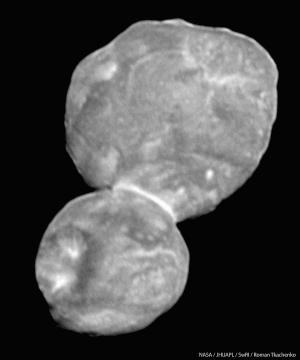
February 17, 2020
Formed from a pebble cloud?
NASA launched the New Horizons spacecraft on January 19, 2006. As Picture of the Day readers recall, New Horizons provided confirmation of Electric Universe principles when it flew by the Pluto/Charon system on July 14, 2015. On January 1, 2019 New Horizons flew by an object near the edge of the Kuiper Belt that was then known as, “Ultima Thule” (2014 MU69), now called, “Arrokoth”; “sky” in the Powhattan/Algonquin language.
At flyby time, Arrokoth was about 6.5 billion kilometers from the Sun, making it the most distant flyby. Arrokoth is approximately 30 kilometers in diameter, with an irregular shape. It is described as a “contact binary”, and is similar in shape to Comet 67P/Churyumov-Gerasimenko.
According to a recent press release, Arrokoth was formed in the early days of the Solar System when it “coalesced” from a “primordial cloud of pebbles”. Since most astrophysical theories are based on the Nebular Hypothesis, NASA researchers depend on that explanation for the shape, and, indeed, the very existence of Arrokoth.
The hypothesis suggests that the Solar System condensed out of a cloud of molecular gases and dust in a period measuring billions of years. The cloud shrank to the point where compression heating started a nuclear chain reaction in the dense ball of hydrogen and helium at the center of the cloud, giving birth to a new star. As material continued to be drawn toward the center of the ever-shrinking mass, it formed a structure called an accretion disc.
Eddies and whirlpools of matter formed in the ring of dust and gas, slowly sucking in larger and larger particles, then pebbles, then boulders, until hundreds of millions of impacts from nebular condensates gradually formed the planets. The “leftovers” are comets, asteroids, meteors and moons. Many of those objects reside in a region called the Kuiper Belt.
Astronomers Kenneth Edgeworth from Ireland and, separately, American astronomer Gerard Kuiper created the Kuiper Belt theory in 1951. The first Kuiper Belt Object (KBO) was discovered in 1992. Sometimes known as “trans-Neptunian Objects”, dozens of KBOs the size of small moon-sized planets have recently been discovered.
One immediate piece of information is that Arrokoth is a reddish color, probably caused by tholin compounds that were discussed in previous Picture of the Day articles. Tholins are large organic molecules that arise when ultraviolet light interacts with smaller molecules. They cannot exist naturally on Earth, because atmospheric oxygen would quickly destroy them. They can be synthesized in laboratory isolation, however, by sending electric arcs through various combinations of methane and ammonia.
In passing, it must be noted that the Star Dust cometary mission demonstrated that the existence of such far away and frigid nurseries like the Kuiper Belt was impossible, because of the minerals found in the comas of objects like Comet Wild II. Those minerals indicate that they formed in a much hotter environment than a hypothetical nebular cloud.
Stephen Smith
The Thunderbolts Picture of the Day is generously supported by the Mainwaring Archive Foundation.












